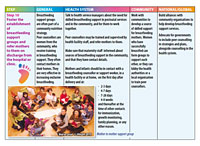|
|
|
Step 10: Foster the establishment of breastfeeding support groups and refer mothers to them on discharge from the hospital or clinic.
Every facility providing maternity services and care for newborn infants should:
Step 10: Foster the establishment of breastfeeding support groups and refer mothers to them on discharge from the hospital or clinic.
Mothers breastfeeding should be explored for their plans for infant feeding after discharge. They should also be able to describe one thing that has been recommended to ensure that they will be linked to a breastfeeding support group (if adequate support is not available in their own families) or report that the hospital will provide follow-up support on breastfeeding if needed.
The nursing officer in charge of the maternity ward should be aware of any breastfeeding support groups in the local area and, if there are any, describe a way mothers are referred to them. Alternatively, she or he should be able to describe a system of follow-up support for all breastfeeding mothers after they are discharged (early postnatal or lactation clinic checkup, home visit, telephone call).
Breastfeeding support groups are often part of a community nutrition strategy. Peer counsellors are women from the community who receive training in breastfeeding support. They often contact mothers in their homes. They are very effective in increasing exclusive breastfeeding.
After the mother is discharged from the hospital, she needs much support to breastfeed. She may have doubts if she was producing enough milk or she may have problems like engorgement or sore nipples. Hence, the tenth step recommends to either put the mother in touch with a breastfeeding support group or to help her have free access to someone in the hospital for advice as and when required.
|
What You Can Do.
 Step 10: WABA Action Chart Step 10: WABA Action Chart
What You or Your Organisation Can Do >> click here
World Breastfeeding Week Action Folders  >> English - Spanish >> English - Spanish
- General
Breastfeeding support groups are often part of a community nutrition strategy.
Peer counsellors are women from the community, who receive training in breastfeeding support. They often contact mothers in their homes. They are very effective in increasing exclusive breastfeeding.
- Health System
Talk to health service managers about the need for skilled breastfeeding support in postnatal services and in the community, and for them to work together.
Peer counsellors may be trained and supervised by health facility staff, and refer mothers to them.
Make sure that maternity staff informed about sources of breastfeeding support in the community, and that they have contact details.
Mothers and infants should be in contact with a breastfeeding counsellor or support worker, in a health facility or at home, on the first day after delivery and at:
- 2-3 days
- 4-7 days
- 7-28 days
- 4-8 weeks
and thereafter at the time of other contacts for immunization, growth monitoring, family planning, or any other reason.
- Community
Work with communities to develop a source of skilled support for breastfeeding mothers. Women who have successfully breastfed can form groups to support each other, or they can lobby the health authorities or a local organisation to train peer counsellors.
- National / Global
Build alliances with community organisations to help develop breastfeeding support services.
Advocate for governments to include peer counselling in strategies and plans, alongside counselling in the health system.
|
Key Points:Follow up should include a list of resources including:
- Telephone hotlines - where possible
- Area Mother-to-Mother support meetings
- Hospitals can provide a lactation clinic, in-home visitation or follow-up phone calls to support breastfeeding moms.
HIV Issues to Consider Step 10: Foster the establishment of breastfeeding support groups and refer mothers to them on discharge from the hospital or clinic. Step 10: Foster the establishment of breastfeeding support groups and refer mothers to them on discharge from the hospital or clinic.
Issues to consider while implementing this step in relation to feeding recommendations for children of HIV-infected mothers and for settings with high HIV prevalence.
- The facility should provide information on MTCT and HIV and infant feeding to support groups and others providing support for HIV-positive mothers in the community.
- The facility should make sure that replacement-feeding mothers are followed closely in their communities, on a one-to-one basis to ensure confidentiality. In some settings it is acceptable to have support groups for HIV-positive mothers.
- HIV-positive mothers are in special need of on-going skilled support to make sure they continue the feeding options they have chosen. Plans should be made before discharge.
- The babies born to HIV-positive mothers should be seen at regular intervals at well baby clinics to ensure appropriate growth and development.
15 August, 2013
|
